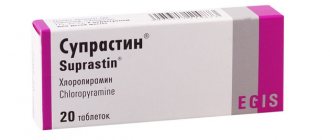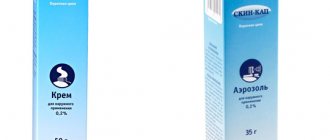Lactofiltrum is a combined action drug that is used to normalize intestinal microflora and strengthen the body. The composition contains sorbene and a prebiotic. The first helps cleanse the body of harmful substances, and the second is responsible for the spread of beneficial bacteria in the body.
Pharmacodynamics, pharmacokinetics
Linguine, which is one of the main active ingredients of the drug, is a non-toxic organic compound. It is obtained from wood after careful processing. The substance has good binding properties, it removes from the body:
- Heavy metal salts
- Allergens
- Excess cholesterol
- Excess bilirubin and urea
- Alcohol
After taking the medication, harmful substances are completely eliminated from the body within one day.
Lactulose is the second active ingredient of the drug; it belongs to the prebiotics. The substance blocks the reproduction of pathogenic organisms.
Experience of using enterosorbents in the complex treatment of atopic dermatitis in children
The prevalence of allergic diseases in children remains high. This is confirmed by numerous clinical observations and the results of epidemiological studies. Atopic dermatitis occupies a leading place in the structure of allergic diseases. Atopic dermatitis is a systemic allergic disease with a complex pathogenesis and characteristic age-related evolution of clinical manifestations. It is characterized by a persistent course, frequent exacerbations and insufficient effectiveness of existing treatment methods.
Over the years, knowledge about the nature of the disease has been improved and deepened, new concepts of pathogenesis have emerged, and terminology has changed. According to the modern concept, the development of atopic dermatitis is based on immunological mechanisms and disorders (dysfunction) of the epidermal barrier. The main pathomorphological changes that occur during atopic dermatitis occur in the epidermis, affecting the dermis in severe, continuously relapsing course of the disease.
Currently, a scientific point of view has emerged that atopic dermatitis develops under the influence of genetic and environmental factors. The antigenic load on the body of factors of exogenous and endogenous origin plays one of the most important roles in the mechanisms of disease development.
Exogenous factors include a variety of allergens (food, household, mite, pollen, fungal, epidermal, medicinal) and nonspecific stimuli (climate, stress, smoking, cold). Endogenous factors constitute the pathological conditions associated with atopic dermatitis. In 80–90% of children with atopic dermatitis, pathological changes are observed in the gastrointestinal tract, in 20–30% in the respiratory system, and in 15–18% in the kidneys. Violation of the barrier function of internal organs contributes to a faster entry of exoallergens into the body. With a long, continuously relapsing course of the disease, the processes of their elimination are disrupted in the vast majority of patients. Products of disturbed metabolism accumulate in tissues and biological fluids, the content of bile acids and the concentration of biologically active substances (histamine, serotonin, eicosanoids, cytokines, etc.) formed in the body during significant antigenic stimulation increase. Endogenous intoxication syndrome develops. Clinically, the syndrome of endogenous intoxication manifests itself in the form of marbling of the skin, acrocyanosis, grayish tint of the skin, dryness and flaking.
For the purpose of detoxification, efferent therapy is used, aimed at removing allergens and toxins from the body. The most effective of them are sorption methods. In pediatric practice, the enterosorption method is most often used - a method based on the binding and removal from the body of allergens, various exogenous and endogenous compounds, pathogenic microorganisms and their metabolic products.
Enterosorption is a treatment method based on the ability of enterosorbents to bind and remove from the body various exogenous substances, microorganisms and their toxins, intermediate and final metabolic products. These substances can accumulate or penetrate into the lumen of the gastrointestinal tract.
Against the background of enterosorption, the functional activity of cellular and humoral immunity increases, the number of T-lymphocytes increases, the severity of eosinophilia decreases, the level of circulating immune complexes decreases, skin itching and swelling decreases, and the frequency and severity of bronchial asthma attacks decreases.
Enterosorbents (ESB) are medical preparations that have a high sorption capacity, are not destroyed in the gastrointestinal tract and are capable of binding exo- and endogenous substances by adsorption, ion exchange or complexation.
The important thing is that sorbents allow you to reduce the dose of hormones, and in some cases even cancel them.
A wide range of sorption agents are used in clinical practice. The therapeutic effect of the sorbent is achieved due to the physicochemical properties of the sorbent substance, which is capable of binding and removing exogenous and endogenous compounds from the body. The decisive role is played by porosity, which is characterized by the presence of pores between grains, layers, and crystals. Sorbents can have micropores, mesopores, macropores. Therefore, the choice of sorbent with different porous structure affects the adsorption of certain toxins, which determines the therapeutic effect of the sorbent.
Enterosorbents are divided according to the following characteristics:
- By dosage form - granules (coals), powders (carbolene, cholestyramine), tablets, pastes, food additives (pectins, chitin).
- According to the chemical structure - activated carbons, aluminosilicates, aluminogel, oxide, organomineral and composite sorbents, dietary fiber.
- By sorption mechanisms - adsorbents, absorbents, ion-exchange materials, sorbents with catabolic properties, sorbents with combined mechanisms.
- By selectivity - selective, mono-, bi-, polyfunctional, non-selective (activated carbons, natural preparations - lignin, chitin, cellulose) [1].
The following requirements apply to modern enterosorbents:
- must not have toxic properties;
- be non-traumatic for mucous membranes;
- good evacuation from the intestines;
- have good functional (sorption) properties;
- do not cause dysbacteriosis;
- have a convenient dosage form.
Of particular interest are sorbents that contain a prebiotic. These products include Lactofiltrum. The drug contains a prebiotic (lactulose) and a sorbent (lignin).
The properties of Lactofiltrum are due to the high sorption capacity of a natural enterosorbent based on lignin. Hydrolytic lignin is a complex natural organic compound, a product of hydrolytic wood processing, and an enterosorbent. Has a nonspecific detoxification effect. Binds, retains and removes from the body various pathogenic microflora, exo- and endotoxins, drugs, heavy metal salts, alcohol, allergens, excess of certain metabolic products (bilirubin, cholesterol, histamine, serotonin, urea, other metabolites responsible for the development of endogenous toxicosis). Due to the large surface area and developed pore system, lignin has a high sorption capacity. Lignin is non-toxic, not absorbed, and is completely eliminated from the intestines within 24 hours.
The second component of Lactofiltrum is lactulose, a synthetic disaccharide consisting of a galactose residue and a fructose residue. In the large intestine, lactulose is fermented by normal intestinal microflora as a dietary substrate. Lactulose stimulates the growth of bifidobacteria and lactobacilli in the large intestine, promotes the normalization of the metabolism of proteins, fats and carbohydrates, the proper absorption of vitamins, macro- and microelements, and also stimulates nonspecific immunity. As a result of the hydrolysis of lactulose, organic acids (lactic, acetic and formic) are formed, which suppress the growth of pathogenic microorganisms and consequently reduce the production of nitrogen-containing toxic substances. The described process leads to an increase in osmotic pressure in the lumen of the large intestine and stimulation of peristalsis. Lactulose is not absorbed by the human body.
The advantage of Lactofiltrum is its dual action: the sorbent neutralizes pathogenic microorganisms and removes intestinal toxins, and the prebiotic stimulates the growth of beneficial microflora (bifidobacteria and lactobacilli). The complex effect of Lactofiltrum components leads to the formation of a powerful protective factor - normal intestinal microflora, elimination of clinical manifestations of dysbiosis, faster disappearance of symptoms of allergic diseases and effective detoxification of the body.
Directions for use and doses
Below is the experience of using Lactofiltrum in complex therapy of children with atopic dermatitis. 36 children aged from two to five years were under observation (n = 26 - main group, n = 10 - control group). There were 20 boys, 16 girls. The duration of the disease ranged from one year to 4.5 years. According to the severity of the disease: 16 children had a moderate course of the disease (SCORAD index = 38.4 ± 1.8 points), 10 patients had a severe course of atopic dermatitis (SCORAD index = 56.5 ± 1.5 points). The comparison group consisted of 10 children with moderate atopic dermatitis who received only traditional therapy.
In children with moderate atopic dermatitis, the skin process was localized in the face, neck with transition to the skin of the forearms and elbows, on the flexor surface of the wrist joints, the back of the hands and in the popliteal fossae. The pathological process was acutely inflammatory in nature and was represented by hyperemia, edema, foci of exudation, excoriation, crusts, and peeling. The skin outside the lesions was dry, with reduced turgor and elasticity. There was moderate itching of the skin.
In children with severe atopic dermatitis, the process was widespread; there was pronounced hyperemia and swelling, pronounced and extensive foci of exudation, papular elements merging into foci of persistent infiltration. Lichenification was pronounced, deep linear cracks, excoriations, and serous-hemorrhagic crusts were observed. All patients experienced severe itching and sleep disturbance.
Lactofiltrum was prescribed orally 3 times a day between meals (1–1.5 hours before or after meals or taking other medications).
Age dosages: children from three to five years old, 1 tablet 3 times a day; and for children from two to three years old, 1/2 tablet 3 times a day. The duration of the course is 2 weeks.
The inclusion of enterosorbent Lactofiltrum in the complex therapy of atopic dermatitis, accompanied by endogenous intoxication syndrome, has significantly reduced the severity of the skin process, itching and dryness of the skin. At the same time, the SCORAD index in children of the main group decreased to 14.6 ± 2.1 and 28.4 ± 1.4 points, respectively (Fig. 1), while in children from the comparison group such a pronounced regression of skin rashes was not observed.
In patients of the main group, during the use of Lactofiltrum, there was a normalization of existing stool disorders. A course of use of Lactofiltrum made it possible to shorten the period of exacerbation (Fig. 2), prolong the remission of the disease by an average of 4.6 ± 2.3 months in children in the main group compared with patients from the comparison group (2.9 ± 1.8 months).
Thus, the inclusion of the drug Lactofiltrum in the complex therapy of children with atopic dermatitis in an age-appropriate dose for 14 days increased the clinical effectiveness of treatment, promoting a more rapid resolution of the skin process, which shows not only a positive short-term effect, but also positive long-term results. The drug is easy to take, non-toxic, and does not cause side effects.
Literature
- Botkina A. S. Use of dioctahedral smectite in children with atopic dermatitis // Issues of modern pediatrics. 2008, vol. 7, no. 2, p. 1–4.
- Methods for correcting dysbiotic intestinal disorders in children with atopic dermatitis. Tutorial. Ed. prof. L. F. Kaznacheeva. Novosibirsk, 2004. 72 p.
- Paliy I.G., Reznichenko I.G. Modern view on the problem of enterosorption: choosing the optimal drug // News of medicine and pharmacy. 2007. No. 11, p. 217.
V. A. Revyakina, Doctor of Medical Sciences, Professor
Research Institute of Nutrition of the Russian Academy of Medical Sciences , Moscow
Contact information about the author for correspondence
How to give Lactofiltrum to children
The drug can be used to treat children over 1 year of age. Regardless of the patient’s age, the drug should be taken 3 times a day. The duration of therapy should be determined by the doctor, but generally the treatment course lasts 14-21 days.
The drug, if there are difficulties with swallowing, can be crushed. You will need warm water for drinking. It is important that the medication must be given to the child an hour before meals. This will help not to interfere with the absorption of nutrients from food and the influence of other pharmaceuticals taken.
Lactofiltrum for acne, how to take
When treating acne, the drug can be effective only if the appearance of acne is caused by a disruption in the digestive tract.
The drug should be taken 1-3 tablets 3 times a day an hour before meals; doctors recommend taking the medicine with water.
The specific dosage should be selected depending on the complexity of the problem. The duration of treatment directly depends on the condition of the skin. The first results will be visible within a day of taking the drug, but it is recommended to complete the entire treatment course, usually it lasts 2 weeks. If necessary, therapy can be repeated after some time.
Contraindications and adverse reactions
The drug should not be taken if:
- intestinal obstruction;
- increased susceptibility to constituent substances;
- hemorrhage in the gastrointestinal tract;
- galactosemia.
It should be taken with great caution in case of intestinal atony and exacerbation of stomach ulcers. The effect of the drug on the condition of a pregnant woman and her unborn child has not been fully studied.
After administration, negative reactions may occur:
- accumulation of gases in the stomach;
- stomach upset;
- allergy.
Improper use of the drug can lead to an overdose, which is manifested by pain in the abdomen or constipation. If you experience such symptoms, you should stop taking it immediately.







